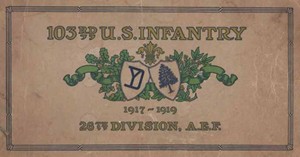
of the 26th Division of the U.S. Army
during World War I
 | The History of the 103rd Regiment of the 26th Division of the U.S. Army during World War I |
| Table of Contents | ||
|
CHAPTER I gTHE[MOBILIZATION AND ORGANIZATION OF THE REGII\/IENT IN an evening 7'v·ansc2·ipt of October, 1917, an editorial entitled “Tl1c Newhlng- land Division" and written after it was known in the states that the division had arrived safely in France, reads in part as follows: "What a brave story it will make sometime! Little by little now, but perhaps sometime grandly and opically, the record of the assembling and departure and arrival of the New England Division will be made. We must be content with glimpses. The old and famous organizations are all there, blended in a new and solid mass, the armed front of the universal Yankee nation." ln no regiment in the division was this blending of organizations better exem- plified than in thc 103rd. Originally it had been intended that the 103rd Regi- ment should be made up entirely of Maine men; but due to the haste with which the New England troops were mobilized it was impracticablc and impossible to bring to VVestf·ield a complete regiment. The result was that when finally or- ganized to strength, there were men from Maine, New Hampshire, Vermont, Massachusetts, and Rhode Island in the regiment. lt will be well to go back and see briefly what these different state units, "the old and famous orp;anizations," had been doing. \Yar was declared on April 6. 'l`he Border Service was but a memory; the National Guard troops had all been mustered out shortly after their return from the South. But now a real and vital situation presented itself, would the National Guard meet the crisis; would it be ablc to recruit up to strength, and how soon, for time was an important element? 'l‘he answer was proved by the fact that the 26th Division was not only the first National Girard division to he sent Io France, but the Hrst complete division —· ltegular Army or National Guard — to arrive in France; it must not be forgotten, however, that the first division (Regular Army) had come to Franco in June. 'llhe foundation on which the 103rd Regiment was built was the 2nd Maine, Uoloncl Frank l\I, Hume of lloulton eenuuanding, headquarters of the regiment being at Augusta. The Maine men had returned from "the Border" (the Mexi- oan affair) in October, 1916, and been mustered out November 25, 1916. April 12, l0l7, they were called out again; war had been declared the week before, and there were some fears as to what form of trouble Germans or German sympa- thizcra might start. Without the regiment being mobilized as a whole, the differ- ont companies were assigned to guard duty, —bridge heads, railroads, etc., throughout the state. At this time, in April, the average strength per company WILH sixty-Five men. During April and May the companies were recruited up to llltl and in June ordered to muster up to a strength of 150 per company, 2002 to a regiment. Early in July the regiment assembled at Camp Keyes, Augusta, Maine. The work of recruiting had gone forward; the response to the call was remarkable; the regiment was the first white regiment in the country to be re- oruited up to the then required strength of 150 men per company. In June one battalion known as the R.ccruit Battalion of six companies (100 per company), Major Southard commanding, was already receiving training. August 5 saw the regiment mustered into the Federal Service. Meanwhile training had been taken up through July and continued to the time of departure for VVestfield, the nineteenth of August. In passing, credit should be given to Colonel Hume, Colonel Parkhurst, and Captain Ashworth for their untiring efforts as recruiting oflicers. In the regiment as it left Maine there was slightly under nity per cent of the men who had had previous service. ln the ranks there was a good percentage of college men, about six hundred, who were either graduates of or students in Maine colleges. Such then was the foundation to which were subsequently added at Camp Bartlett, W estlield, detachments from other New England regiments. The new organization called for regimental strength of 3600, and it was from the lst New Hampshire that the largest percentage of the deficiency was drawn. The lst New Hampshire, Colonel Healy commanding, with headquarters at Manchester, was called out July 25, 1917, and assembled at Camp Keyes at Concord July 27. The companies had been recruited to strength of 150 per com- pany before going to Concord. The regiment was mustered into Federal Service August 5, 1917. The New Hampshire men had been on the border also. At the time of the mobilization at Concord the regiment was greatly handicapped by shortage of clothing and equipment, Though details had been sent ahead to prepare the camp ground there was much left to do even after its arrival in the way of clearing the site of brush, trees, and stumps, so that the actual instructions in drill which many of the men received prior to arrival at V/estfield was very limited. The regiment came to Vtiestlicld August 27 and was at once split up by the sending of replace- ments to the 103rd and 104th Infantry Regiments. Among the otlicers assigned to the 103rd were Captains Edes and \Vall | ||
| Original Version of Page |